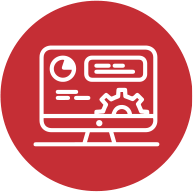Working more efficiently in healthcare thanks to software robots

20+ processes automated across various departments including Finance, HR, and Healthcare Administration

Knowledge and expertise secured in our own RPA Center of Excellence

Addressing staffing shortages, improving data quality, reducing processing times, and enhancing overall operational efficiency
UMC Utrecht addresses tight labor market by intelligently automating processes
Healthcare employees often spend a significant amount of time on repetitive and administrative tasks. However, a considerable number of those tasks can be effectively handled by a software robot, allowing employees to have more time for more valuable and enjoyable work. The University Medical Center Utrecht (UMCU) is steadily working on deploying software robots for administrative work.
“Our directive from the management is to implement as much automation as possible in the various divisions and departments of the UMC.”
Hans Zekveld | Automation Lead at the Process and Test Automation Team of UMC Utrecht
He and his team are responsible for the entire automation process of the hospital in the city of Utrecht, including test automation and further automation. The automation started with test automation but has since evolved into a wide range of digital employees improving processes. Zekveld explains:
“Our team was already working with test automation. We saw how much time you could save with it. Automating our tests reduced 80 hours of work by people to just one night by the robot and some manual review. This means a saving of 80 hours per release, and at least six times a year. That is significant.”
Hans Zekveld | Automation Lead at the Process and Test Automation Team of UMC Utrecht

Employees immediately enthusiastic
The question was quickly whether similar benefits could be achieved with the automation of production processes. Employees of UMCU often had to deal with forms where a lot of data had to be filled in manually. “That was a lot of work, and we started looking for process automation tools.”
“At the same time, we looked within the organization for a partner willing to explore those possibilities. That became HR, a department where much was done manually. They were immediately enthusiastic and wanted to participate. Together with a dedicated project leader, we looked at which processes they would like to see automated.”

Start with a transparent business case
Based on the user’s needs, UMCU issued a request for proposals from various parties, three of which made it to the shortlist. “Ultimately, we chose Tacstone Technology, a UiPath partner.”
“What we appreciated was that they really listened to us. They asked what we needed instead of filling in what they thought we needed. We had to clarify our business case, forcing us to think about what we really wanted. This showed their commitment to the customer and their willingness to help. They did that very well, asking the right questions.”
Hans Zekveld | Automation Lead at the Process and Test Automation Team of UMC Utrecht
An analysis was made of the various processes that were eligible, resulting in two processes for the pilot. “One of them was archiving certain data from new employees, such as medical documents and diplomas. These need to be stored in their personnel file. That is a fairly tedious and time-consuming task, so we set up a system where these documents are placed in a certain folder, and the robot processes and saves these documents in the file.”
Reducing workload during COVID-19
The other process was the processing of vaccination and test reports related to COVID-19, where the data of an employee who has been vaccinated or tested was processed and stored in their medical file. “In both processes, the robots were particularly efficient and quickly paid for themselves.” The archiving robot is still running successfully every day, while the ‘COVID-robot’ is now naturally needed less often. “This shows that there is also a cycle in these processes. Sometimes something is completed and redundant at a certain moment.”
“One of the strengths of Tacstone Technology was their excellent guidance. They clearly explained what the robot would do. That guidance was crucial for the success of the project.”
Hans Zekveld | Automation Lead at the Process and Test Automation Team of UMC Utrecht
The execution of the project turned out to take more time than initially thought. “The main delaying factor was the authorizations. That was a lesson for us: arranging authorizations always takes time, especially in an organization like a hospital, where things sometimes have to be arranged through multiple channels.”

Software robots help solve workforce shortage
The Board of Directors also saw the value of the business case. “It is actually a necessary innovation. This can contribute to more efficient working with fewer staff, which is currently important due to the shortage of staff. So, as a hospital, we have to make smart choices. Based on that, more budget has been made available for this project.”
For scaling up, UMCU has decided to take on part of the project management itself. “Many organizations completely outsource this, but we did not want that. We have the knowledge about projects in-house. We do not have the specific knowledge about automation, as we do not have the capacity for that. In that aspect, we collaborate with Tacstone Technology, which helped set up a Center of Excellence. Anyone who wants to automate something can go there.”
“We find it important that people in the organization have their own experts, their own ‘guild members’ as we call them, who can spar with each other. We then take care of the infrastructure and tools and develop robots. There are also departments, such as the healthcare administration, where development is done by their own employees. But this department also works closely with us and is represented in the RPA guild.
“We now have internal developers, in a fifty-fifty distribution of internal and external developers. We find it important to have a safety net, but our goal is to be able to do it ourselves.”
Hans Zekveld | Automation Lead at the Process and Test Automation Team of UMC Utrecht
Number of software robots will grow exponentially
At this moment, UMCU has about twenty software robots running, with some robots assisting in multiple processes. For example, a software robot helps draft a dismissal letter. The employment contract is also processed automatically. “It is important that there is always human control over those documents due to their importance.”
“With our current number of employees, about 12,000, about 40 to 50 of these letters can be sent weekly, so the time saved by automating these processes is significant. In general, we see that many of our robots pay for themselves within six months. Therefore, we expect the number of software robots to grow exponentially in the coming years.”
Would you like to get to know this new technology like UMCU? And discover the benefits it offers for your organization? Then contact us for an introductory meeting and/or demo.

